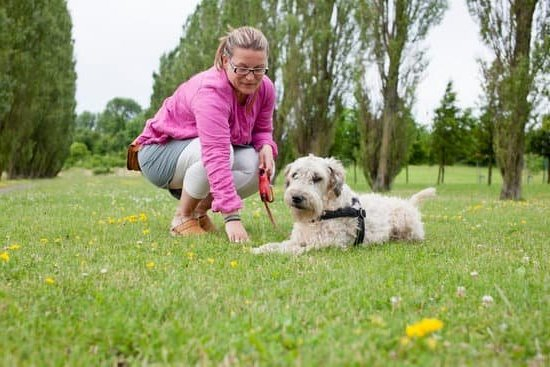Training sticks are essential tools in dog training, providing a unique way to communicate commands and enforce positive behavior. In this article, we will delve into the world of training sticks for dogs, answering the question: what is the training stick for dogs? These tools are designed to aid in obedience training and address behavioral issues effectively.
A training stick is a long, lightweight stick typically made of plastic or fiberglass, with a colored tip at one end for visual cues. This tool serves as an extension of the trainer’s arm, helping to direct a dog’s attention and guide their movements during training sessions. The purpose of a training stick is to provide clear signals to the dog without being physically intimidating, making it a valuable asset in shaping desired behaviors.
There are various types of training sticks available, ranging from traditional ones with a pointed end for pointing and directing to softer versions with padded tips for gentle reinforcement. Each type caters to different training styles and preferences. By understanding the differences between these options, dog owners can choose the right training stick that suits their dog’s needs and comfort level.
What Is a Training Stick
A training stick, also known as a training wand or target stick, is a useful tool commonly used in dog training to provide clear communication and guidance to dogs during obedience training, agility training, or behavior modification. The primary purpose of a training stick is to serve as an extension of the trainer’s hand, allowing for more precise direction and reinforcement of desired behaviors in dogs.
These sticks are typically made of lightweight materials like plastic or fiberglass with a comfortable handle on one end and a distinct tip on the other end that can be used as a target for dogs to touch or follow. The length of the training stick can vary depending on the specific needs of the dog and the type of training being conducted.
One of the key benefits of using a training stick in dog training is its versatility and effectiveness in teaching dogs various commands and tricks. By providing a visual cue with the stick, trainers can easily shape behaviors such as sitting, standing, walking in specific directions, jumping over obstacles, or even performing complex agility courses. Additionally, the consistency and precision offered by a training stick help eliminate confusion and ambiguity for dogs during training sessions.
| Training Stick Benefits | Description |
|---|---|
| Precision | Allows for precise direction and reinforcement of desired behaviors. |
| Versatility | Effective in teaching various commands and tricks. |
| Clarity | Reduces confusion by providing clear visual cues to dogs. |
Different Types of Training Sticks for Dogs
Training sticks come in a variety of shapes and sizes, each serving a specific purpose in dog training. One common type is the classic wooden training stick, which is often used for basic obedience commands such as sit, stay, and heel. These sticks are lightweight and easy to handle, making them ideal for beginners who are learning how to effectively communicate with their canine companions.
Another popular type of training stick is the retractable target stick. This tool features a long shaft with a small ball or target at the end, which can be extended or retracted based on the desired length. Retractable target sticks are commonly used for shaping behaviors and teaching advanced tricks to dogs. The target at the end provides a clear point of reference for dogs to follow, making it easier for them to understand what is expected of them.
For more specialized training needs, there are also electronic training sticks available on the market. These high-tech devices can emit sound or vibration cues to help reinforce positive behaviors or redirect unwanted actions.
Electronic training sticks are particularly useful for working with sensitive or reactive dogs who may require additional support during training sessions. Regardless of the type of training stick you choose, it is important to use it in conjunction with positive reinforcement techniques to ensure a successful and harmonious relationship with your furry friend.
Benefits of Using Training Sticks in Dog Training
Training sticks are versatile tools that can greatly benefit the training process for dogs of all ages and breeds. These tools provide a physical extension of the handler’s arm, allowing for more precise communication with the dog during training sessions. Training sticks can be used in various scenarios, including obedience training, agility training, and behavior modification.
Enhanced Communication
One of the key benefits of using a training stick is the ability to communicate more effectively with your dog. The stick can be used as a visual aid to help direct your dog’s attention and focus on specific commands or behaviors. By using consistent cues with the training stick, you can reinforce desired behaviors and discourage unwanted ones. This clear communication helps strengthen the bond between you and your furry companion.
Physical Distance
Another advantage of incorporating a training stick into your dog training routine is the ability to maintain physical distance between you and your pet. This can be particularly helpful when working with reactive or fearful dogs who may not respond well to close proximity. The stick allows you to guide and redirect your dog from a safe distance, reducing the risk of accidental nips or bites during training sessions.
Consistent Feedback
Training sticks provide a consistent means of feedback for your dog. Instead of relying solely on verbal commands or hand signals, the physical touch of the stick offers tactile feedback that reinforces good behavior or corrects unwanted behaviors. This consistency helps accelerate the learning process for dogs by making commands more tangible and easier to understand. Overall, using a training stick in conjunction with positive reinforcement techniques can lead to faster progress in your dog’s training journey.
How to Choose the Right Training Stick for Your Dog
When it comes to choosing the right training stick for your dog, there are several factors to consider to ensure effective and safe training sessions. The first step is to understand the different types of training sticks available in the market. Training sticks can vary in length, material, and design, so it’s essential to select one that suits your dog’s size, temperament, and training needs.
Consider Your Dog’s Size and Breed
One crucial factor to consider when choosing a training stick for your dog is their size and breed. Larger dogs may require a longer and sturdier training stick for better control during training sessions. On the other hand, smaller breeds may benefit from a shorter and lighter stick that is easier to handle. It’s also essential to consider your dog’s breed characteristics – for example, some breeds may respond better to certain types of training sticks.
Choose a Comfortable Handle
Another important consideration when selecting a training stick for your dog is the handle design. It’s essential to choose a stick with a comfortable grip that provides you with good control while working with your dog. Look for handles that are ergonomically designed and easy to hold for extended periods without causing discomfort or fatigue. A comfortable handle will not only make training more effective but also enhance your overall experience during training sessions.
Quality and Durability
When choosing a training stick for your dog, opt for one that is made from high-quality materials that ensure durability. A sturdy and durable stick will be able to withstand the rigors of regular use without breaking or wearing out quickly.
Investing in a quality training stick may cost more initially but will pay off in the long run by lasting through numerous training sessions effectively. Additionally, ensure that the stick is lightweight yet robust enough to maintain control over your dog without causing harm or discomfort during obedience exercises.
Top Training Techniques Using a Training Stick
Training sticks are invaluable tools when it comes to training dogs effectively. The way you use a training stick can greatly impact your dog’s behavior and obedience. One of the top training techniques using a training stick is known as target training. This involves teaching your dog to touch or follow the stick, which can be helpful in guiding them into certain positions or movements.
Another effective technique is using the training stick for distance control. By extending the length of the stick, you can direct your dog from a distance without having to physically move closer to them. This can be handy for commands like “stay” or “come” where you need to maintain a particular distance from your dog.
Furthermore, shaping behavior through reinforcement is a key technique with training sticks. You can use the stick to mark and reward desired behaviors in order to shape your dog’s actions over time. This positive reinforcement method helps strengthen the bond between you and your furry friend while promoting good behavior.
| Training Technique | Description |
|---|---|
| Target Training | Teaching the dog to touch or follow the stick for guidance. |
| Distance Control | Directing the dog from afar using an extended training stick. |
| Shaping Behavior | Marking and rewarding desired behaviors with the training stick. |
Common Mistakes to Avoid When Using a Training Stick
When using a training stick for dogs, it is crucial to be aware of common mistakes that can hinder the effectiveness of your training sessions and potentially harm your furry companion. One common mistake to avoid is using too much force or aggression when using the training stick.
The purpose of the stick is not to cause physical harm, but rather to provide a visual cue or redirection for your dog. Applying excessive force can lead to fear, anxiety, and even aggression in your dog, which would defeat the purpose of positive reinforcement in training.
Another mistake to avoid is inconsistency in your use of the training stick. Dogs thrive on routine and consistency, so it is important to establish clear communication with your pet when using the stick. Ensure that you are using consistent cues and signals when incorporating the stick into your training sessions. Inconsistencies can confuse your dog and make it difficult for them to understand what behavior is being reinforced or corrected.
Lastly, a common mistake when using a training stick for dogs is neglecting proper timing and precision. Timing is key in reinforcement training, as dogs associate consequences with their actions almost immediately.
If you are late in providing positive reinforcement or correction with the stick, your dog may not understand what behavior they are being rewarded or redirected for. It is essential to be precise in your movements and timing when using the training stick to effectively communicate with your canine companion.
Alternatives to Training Sticks for Dog Training
When it comes to training dogs, there are various tools and methods available to help facilitate effective learning and behavior modification. While training sticks can be a useful tool in dog training, it’s important to recognize that they may not be suitable for every dog or owner. Thankfully, there are alternative options that can still aid in training without the use of a traditional training stick.
Here are some alternatives to consider when exploring different training methods for your dog:
- Clicker Training: Clicker training is a popular positive reinforcement method that uses a small handheld device that emits a clicking sound to mark desired behaviors. This method can be highly effective in shaping behavior and building communication between you and your dog.
- Treat Pouches: Treat pouches are convenient tools for carrying rewards during training sessions. By using treats as positive reinforcement, you can motivate your dog to learn new commands and behaviors effectively.
- Target Sticks: Target sticks are similar in design to training sticks but are used primarily for targeting specific objects or areas. They can help guide your dog’s movements and encourage them to perform specific tasks with precision.
While these alternatives can be just as effective as using a traditional training stick, it’s important to assess your dog’s individual needs and preferences before deciding on the best approach. Every dog is unique, so experimenting with different methods may help you determine what works best for your canine companion.
Ultimately, the key is to establish a positive and trusting relationship with your dog through consistent training practices. Whether you choose to use a training stick or explore other options, the most important aspect of successful dog training is patience, consistency, and understanding of your furry friend’s behavior and needs.
Safety Precautions When Using Training Sticks With Dogs
When using training sticks with dogs, it is crucial to prioritize safety for both you and your furry companion. While training sticks can be effective tools in teaching and guiding your dog, improper use can lead to negative consequences. Here are some important safety precautions to keep in mind when utilizing a training stick in your dog’s training regimen:
- Choose the right size and material: Ensure that the training stick you choose is appropriate for your dog’s size and strength. Opt for a sturdy yet lightweight stick that is easy to handle.
- Always supervise training sessions: When using a training stick with your dog, it is essential to remain present and attentive during the entire session. This allows you to monitor your dog’s response to the stick and intervene if necessary.
- Avoid hitting or striking the dog: The purpose of a training stick is not to physically harm or punish your dog. Instead, use it as a tool for guidance and redirection. Avoid using excessive force or making contact with your dog’s body.
Taking these safety precautions will help create a positive training experience for both you and your canine companion while using a training stick. By prioritizing safety, you can effectively communicate with your dog and strengthen the bond between you two through training sessions. Remember that consistency, patience, and kindness are key components of successful dog training techniques.
- Gradually introduce the training stick: Before incorporating the training stick into formal training sessions, allow your dog to become familiar with it in a non-threatening manner. Let them sniff, investigate, and gradually get used to the presence of the stick.
- Reward good behavior: Use treats, praise, or toys as positive reinforcements when your dog responds correctly to commands or cues given with the training stick. This encourages them to associate obedience with rewards rather than fear or punishment.
- Seek professional guidance if needed: If you are unsure about how to properly use a training stick or if you encounter difficulties during the training process, do not hesitate to consult with a certified dog trainer or behaviorist. They can provide valuable insights and techniques tailored to your unique situation.
Conclusion
As we conclude our exploration of training sticks for dogs, it becomes apparent that these tools play a vital role in canine behavior and obedience. By providing clear communication and consistent feedback to our furry companions, training sticks can effectively aid in teaching new commands, correcting unwanted behaviors, and reinforcing positive actions. It is essential to recognize the significance of using the right training stick in conjunction with proper techniques to ensure successful training outcomes.
One key aspect of understanding what a training stick is for dogs lies in selecting the appropriate type based on your dog’s needs and preferences. Whether you choose a traditional stick, a target stick, or a retractable stick, each option offers unique benefits tailored to specific training objectives. Additionally, knowing how to utilize the chosen training stick correctly can make all the difference in fostering a positive learning experience for your dog.
Furthermore, incorporating safety precautions into your training routine with training sticks is crucial to prevent any potential harm or discomfort to your furry friend. Always supervise your dog during training sessions, avoid using excessive force or aggression, and be mindful of your dog’s body language and responses.
With patience, consistency, and a deep understanding of the impact of training sticks on canine behavior and obedience, you can build a strong bond with your dog based on trust, respect, and effective communication.
Frequently Asked Questions
How Do You Use a Dog Training Stick?
Using a dog training stick involves using it as an extension of your hand to guide your dog during training. The stick can be used to point, direct, or tap certain areas to communicate expectations to your dog effectively.
What Is a Target Stick Used for in Dog Training?
A target stick is commonly used in dog training to teach dogs specific behaviors like touching the stick with their nose or following it in a desired direction. This tool helps trainers shape behaviors and improve focus during training sessions.
How Do You Use a Dog Healing Stick?
A dog healing stick is typically used as a healing aid for dogs with injuries or mobility issues. By providing support and stability, the healing stick allows dogs to move more comfortably and promotes proper healing of affected limbs or joints.

Welcome to the blog! I am a professional dog trainer and have been working with dogs for many years. In this blog, I will be discussing various topics related to dog training, including tips, tricks, and advice. I hope you find this information helpful and informative. Thanks for reading!





